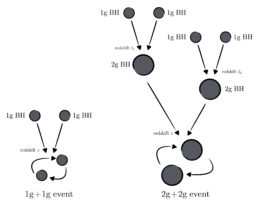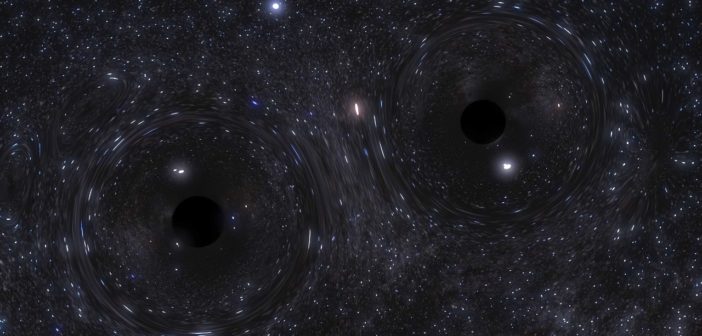The recent successes of the Laser Interferometer Gravitational-Wave Observatory (LIGO) has raised hopes that several long-standing questions in black-hole physics will soon be answerable. Besides revealing how the black-hole binary pairs are built, could detections with LIGO also reveal how the black holes themselves form?
Isolation or Hierarchy
The first detection of gravitational waves, GW150914, was surprising for a number of reasons. One unexpected result was the mass of the two black holes that LIGO saw merging: they were a whopping 29 and 36 solar masses.

On the left of this schematic, two first-generation (direct-collapse) black holes form a merging binary. The right illustrates a second-generation hierarchical merger: each black hole in the final merging binary was formed by the merger of two smaller black holes. [Adapted from Gerosa et al., a simultaneously published paper that also explores the problem of hierarchical mergers and reaches similar conclusions]
A team of scientists led by Maya Fishbach (University of Chicago) suggests that we may soon be able to tell whether or not black holes observed by LIGO formed hierarchically. Fishbach and collaborators argue that hierarchical formation leaves a distinctive signature on the spins of the final black holes — and that as soon as we have enough merger detections from LIGO, we can use spin measurements to statistically determine if LIGO black holes were formed hierarchically.
Spins from Major Mergers
When two black holes merge, both their original spins and the angular momentum of the pair contribute to the spin of the final black hole that results. Fishbach and collaborators calculate the expected distribution of these final spins assuming that all the hierarchical mergers are so-called “major mergers” — i.e., the smaller black hole of the pair is at least 70% of the mass of the larger one.

Distribution of spins for 4th-generation mergers, with two different mass ratios (q = 0.7 and q = 1) and initial first-generation spins (non-spinning and maximally spinning). [Fishbach et al. 2017]
Testing the Model
What does this tell us? Since the hierarchical merger model predicts a very specific distribution of spins for the black holes detected by LIGO, we can compare future LIGO detections to see if they’re consistent with this model.
The authors calculate the statistics to show that after order ~100 LIGO detections, we should be able to tell whether these black holes are consistent with a hierarchical merger formation model or not. With luck, this could mean that we will have solved this mystery within a few years of advanced LIGO operations!
Citation
Maya Fishbach et al 2017 ApJL 840 L24. doi:10.3847/2041-8213/aa7045


1 Comment
Pingback: LIGO's BHs: bigger ones that ate smaller ones?